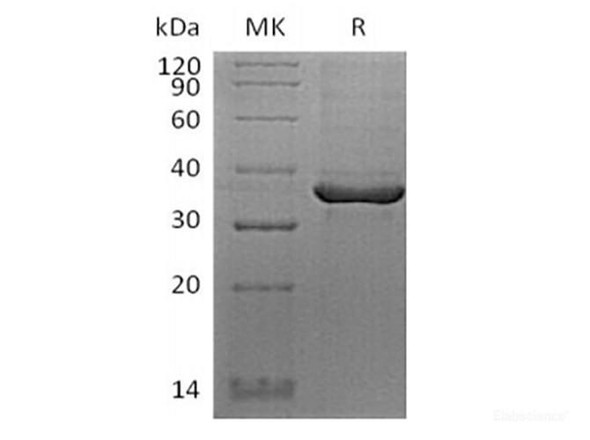Description
| Product Name: | Recombinant Human SLAM Family Member 5/SLAMF5/CD84(C-6His-Avi) Biotinylated |
| Product Code: | RPES6353 |
| Size: | 20µg |
| Species: | Human |
| Expression Host: | HEK293 Cells |
| Synonyms: | SLAM family member 5, Cell surface antigen MAX.3, Hly9-beta, Leukocyte differentiation antigen CD84, Signaling lymphocytic activation molecule 5, CD84, SLAMF5 |
| Mol Mass: | 24.9 kDa |
| AP Mol Mass: | 40-50 kDa |
| Tag: | C-6His-Avi |
| Purity: | > 95 % as determined by reducing SDS-PAGE. |
| Endotoxin Level: | < 1.0 EU per μg of the protein as determined by the LAL method. |
| Bio Activity: | Testing in progress |
| Sequence: | Lys22-Arg220 |
| Accession: | Q9UIB8 |
| Storage: | Generally, lyophilized proteins are stable for up to 12 months when stored at -20 to -80°C. Reconstituted protein solution can be stored at 4-8°C for 2-7 days. Aliquots of reconstituted samples are stable at < -20°C for 3 months. |
| Shipping: | This product is provided as lyophilized powder which is shipped with ice packs. |
| Formulation: | Lyophilized from a 0.2 μm filtered solution of PBS, pH 7.4. Normally 5 % - 8 % trehalose, mannitol and 0.01% Tween80 are added as protectants before lyophilization. Please refer to the specific buffer information in the printed manual. |
| Reconstitution: | Please refer to the printed manual for detailed information. |
| Background: | SLAM family member 5 (SLAMF5/CD84) is a type I transmembrane protein in the SLAM subgroup of the CD2 family. SLAM family proteins regulate multiple aspects of immune system function. Mature human CD84 consists of a 204 amino acid (aa) extracellular domain (ECD) with two Iglike domains,a 21 aa transmembrane segment, and a 99 aa cytoplasmic domain with two immunoreceptor tyrosinebased switch motifs (ITSMs). CD84 exhibits homophilic binding which is mediated by the N-terminal Ig-like domain. Ligation induces tyrosine phosphorylation in the cytoplasmic ITSMs which then recruit the signaling adaptor molecules SAP (SLAM-associated protein) and EAT-2(EWS/Fli1-activated transcript 2).CD84 signaling inhibits Fc epsilon RI-induced mast cell activation but enhances platelet activation. LPS-induced macrophage activation,T cell proliferation and IFN-γproduction, and the interactions between T cells and B cells that are required for germinal center formation. |






